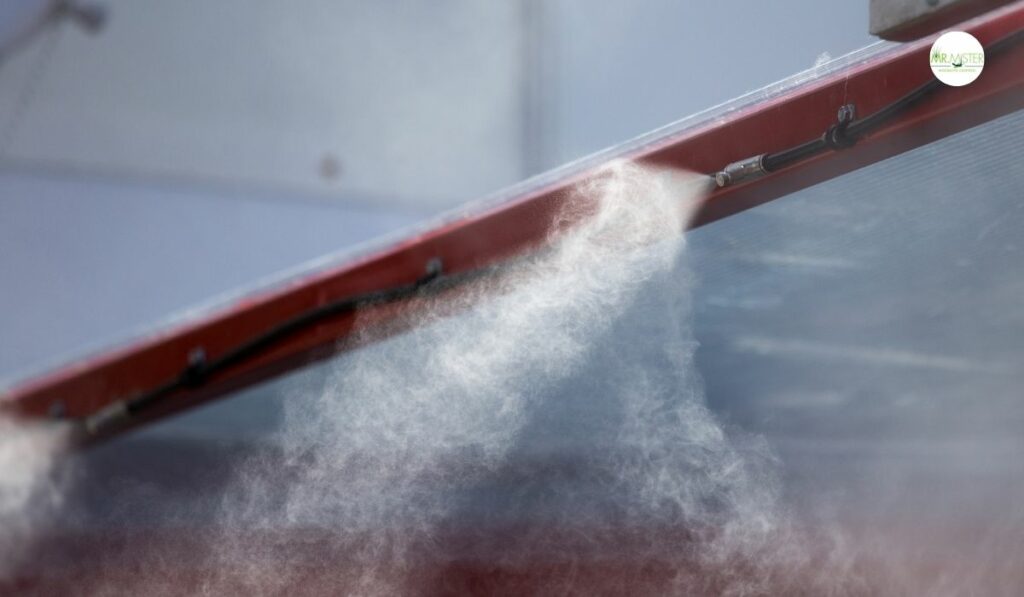What are mosquito misting systems, and how do they work?
Mosquitoes, the tiny yet persistent bloodsuckers, have long been a nuisance to outdoor activities, threatening to turn a pleasant evening into a battle against itching welts and potential diseases.
To combat these pests, various solutions have been devised, one of which is the mosquito misting system.
In this article, we delve into what mosquito misting systems are and how they effectively work to keep these pesky insects at bay.
Understanding Mosquito Misting Systems
A mosquito misting system is a device designed to control mosquito populations in outdoor areas by dispensing a fine mist of insecticide.
These systems are commonly installed in residential yards, commercial properties, outdoor restaurants, and recreational areas where mosquito control is essential.
Components of a Mosquito Misting System
Mosquito misting systems typically consist of several key components:
- Misting Nozzles: These are strategically placed around the perimeter of the area to be protected. The number and placement of the nozzles depend on the size and layout of the region.
- Tubing: High-pressure tubing connects the misting nozzles to the central unit where the insecticide is stored and pressurized.
- Central Unit: This is the heart of the mosquito misting system. It houses the reservoir for the insecticide, a pump to pressurize the system, and a timer or remote control for activating the misting cycles.
- Insecticide: Mosquito misting systems use specially formulated insecticides that are safe for humans and pets but lethal to mosquitoes and other flying insects.
How Mosquito Misting Systems Work
The operation of a mosquito misting system can be broken down into several steps:
Pressurization: The central unit pressurizes the insecticide stored in the reservoir, typically using a high-pressure pump.
This pressurization ensures that the insecticide is delivered to the misting nozzles at the desired flow rate and consistency.
Misting Cycles: The misting system is programmed to release short bursts of insecticide at regular intervals, typically during the times when mosquitoes are most active, such as dawn and dusk.
These misting cycles can be scheduled using a timer or activated manually using a remote control.
Dispersion: When the misting cycle is activated, the pressurized insecticide is forced through the tubing and out of the misting nozzles as a fine mist.
This mist effectively disperses throughout the protected area, coating vegetation, structures, and other surfaces where mosquitoes are likely to rest or breed.
Insecticide Contact: When mosquitoes come into contact with the insecticide mist, it quickly incapacitates and kills them.
Additionally, the residual effect of the insecticide can deter other mosquitoes from entering the treated area for a certain period, providing extended protection.
Refilling and Maintenance: Periodic refilling of the insecticide reservoir and routine maintenance of the misting system components are essential to ensure continued effectiveness and reliability.
Benefits of Mosquito Misting Systems
Mosquito misting systems offer several benefits for controlling mosquito populations:
- Effective Mosquito Control: By targeting mosquitoes at their resting and breeding sites, mosquito misting systems can significantly reduce mosquito populations in the treated area.
- Convenience: Once installed and programmed, mosquito misting systems operate automatically, requiring minimal intervention from the user.
- Customization: The misting cycles can be customized to match the specific needs and preferences of the user, allowing for optimal control of mosquito activity.
- Safe for Humans and Pets: Most insecticides used in mosquito misting systems are formulated to be safe for humans and pets when used as directed, minimizing the risk of exposure.
Types of Mosquito Misting Systems:
Automated Systems: These systems are equipped with timers or sensors that automatically activate misting cycles at predetermined times or when mosquito activity is detected.
They offer convenience and hands-free operation for users.
Remote-Controlled Systems: Some mosquito misting systems come with remote controls that allow users to activate misting cycles as needed manually.
This feature provides flexibility and control over when and how often the system operates.
Integrated Systems: Certain mosquito misting systems can be integrated with existing home automation or irrigation systems, allowing for seamless operation and control through a single interface.
Considerations for Installation:
Placement of Nozzles: Proper misting nozzle placement is crucial for maximizing coverage and effectiveness.
Nozzles should be positioned to create overlapping misting zones and target areas where mosquitoes are likely to rest or breed, such as foliage, bushes, and shaded areas.
Maintenance Requirements: Regular maintenance of mosquito misting systems is essential to ensure optimal performance and longevity.
This includes cleaning and inspecting nozzles, checking for leaks or clogs in the tubing, and replenishing insecticide as needed.
Insecticide Selection: The choice of insecticide is an important consideration when installing a mosquito misting system.
Users should select an insecticide that is effective against mosquitoes and other target insects while being safe for humans, pets, and the environment.
Environmental Impact and Safety:
- Biodegradable Formulations: Many manufacturers offer insecticides with biodegradable formulations that break down quickly in the environment, minimizing potential harm to non-target organisms.
- Integrated Pest Management (IPM) Practices: Mosquito misting systems can be incorporated into an integrated pest management approach, which combines various control methods to minimize reliance on chemical insecticides and reduce environmental impact.
- Regulatory Compliance: Users should familiarize themselves with local regulations and restrictions regarding the use of mosquito misting systems and insecticides to ensure compliance with safety and environmental standards.
Cost Considerations:
- Initial Investment: The cost of purchasing and installing a mosquito misting system can vary depending on factors such as system size, complexity, and brand. Users should consider their budget and specific needs when selecting a system.
- Operational Costs: In addition to the initial investment, users should budget for ongoing operational costs, including the purchase of insecticide refills, routine maintenance, and any required repairs or replacements.
- Cost-Benefit Analysis: While mosquito misting systems can offer effective mosquito control, users should weigh the costs against the potential benefits, such as reduced mosquito bites and the prevention of mosquito-borne diseases, to determine if the investment is justified.
Conclusion:
Mosquito misting systems represent a valuable tool in the fight against mosquito-borne illnesses and nuisance biting.
By understanding how these systems work, as well as their various types, installation considerations, and environmental impact, users can make informed decisions about implementing mosquito control measures on their properties.
With proper installation, maintenance, and responsible insecticide management, mosquito misting systems can provide effective and long-lasting protection for outdoor spaces, allowing users to enjoy their time outdoors without the annoyance of mosquito bites.
If you are interested in exploring mosquito misting systems further or seeking professional assistance in installation and maintenance, feel free to contact us at Mr. Mister Mosquito Control.
FAQs
What are mosquito misting systems?
Mosquito misting systems are devices designed to control mosquito populations in outdoor areas by dispensing a fine mist of insecticide. They are commonly used in residential yards, commercial properties, outdoor restaurants, and recreational areas where mosquito control is essential.
How do mosquito misting systems work?
Mosquito misting systems work by pressurizing insecticide stored in a central unit and releasing it through misting nozzles strategically placed around the area to be protected. This mist effectively disperses throughout the region, coating surfaces where mosquitoes rest or breed. When mosquitoes come into contact with the fog, it quickly incapacitates and kills them.
What are the components of a mosquito misting system?
Mosquito misting systems typically consist of misting nozzles, high-pressure tubing, a central unit containing the insecticide reservoir and pump, and a timer or remote control for activating misting cycles. They use specially formulated insecticides that are safe for humans and pets.
What are the benefits of mosquito misting systems?
Mosquito misting systems offer effective mosquito control by targeting mosquitoes at their resting and breeding sites. They operate automatically, requiring minimal intervention from users, and can be customized to match specific needs and preferences. Most importantly, the insecticides used are safe for humans and pets when used as directed.
What types of mosquito misting systems are available?
There are three main types of mosquito misting systems: automated systems, remote-controlled systems, and integrated systems. Computerized systems use timers or sensors to activate misting cycles; remote-controlled systems allow manual activation, and integrated systems can be connected to existing home automation or irrigation systems for seamless operation.
What considerations are essential for installing mosquito misting systems?
Proper placement of misting nozzles, regular maintenance, and careful selection of insecticides are crucial for optimal performance. Nozzles should be positioned to create overlapping misting zones, maintenance should include cleaning and inspecting components, and users should choose insecticides that are effective against mosquitoes while being safe for humans, pets, and the environment.
What environmental impact and safety considerations should be taken into account?
Opting for biodegradable insecticide formulations, integrating mosquito misting systems into integrated pest management practices, and ensuring compliance with local regulations is essential for minimizing environmental impact and ensuring safety.
What cost considerations should users be aware of?
Users should consider both the initial investment and ongoing operational costs when purchasing and installing mosquito misting systems. This includes the cost of system components, insecticide refills, routine maintenance, and any necessary repairs or replacements. Conducting a cost-benefit analysis can help determine if the investment is justified based on the potential benefits of reduced mosquito activity and prevention of mosquito-borne diseases.
* Schedule a Free Mosquito Control Consultation – 404-941-0720 *
* Guaranteed Results * 100% Biodegradable * Locally Owned







